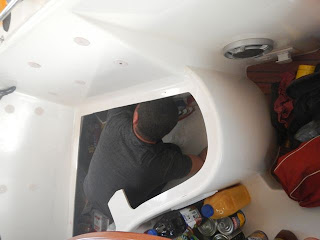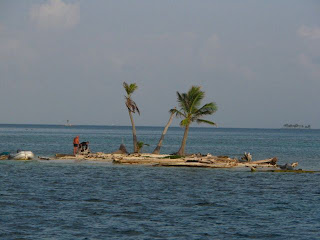... after the obligatory rig-check, the departure was set for around April 19 and we were looking for an opportune weather forecast for the 600 miles passage across the Caribbean Sea towards Cartagena on the Colombian atlantic coast. But instead of finding the weather window we found Rainer, a fellow cruiser with some more experience [than we had] about radios and computing.
One of the two main issues that kept bothering us over the past 6 or more months were not being able to use our HF radio and attached pactor modem to access weather forecasts and emails while at sea. Each time we tuned or changed frequencies on the radio quite a few of our auxiliary electronic equipment like board computer, inverter or LED lights just to name a few were crashing or switching on or off, without apparent reason. To cut a long story very short now – Rainer has the reputation [according to partner Ulli] to never give up – and he didn’t. He ploughed with us through all the possible options of how to solve the problem. The solution was to abandon the fickle and badly insulated board computer and rig up our laptops to communicate with the vicious high frequency radio waves. Thank you, Rainer !!!
While solving the radio issue we also happened to find the solution to the problem why our second set of new AGM batteries [first set of 3 we exchanged as precaution on the Canary Islands before the transatlantic] wouldn’t charge properly nor being able to hold the charge. It was a simple ‘loose screw connection’ …. no more, but hidden away in a maze of cables and connectors. A good result as the rest of our power management installation is now working perfectly.
Reinvigorated by solutions to problems we set off on April 21 to catch the tail end of a northerly low that came down via the Bahamas and Florida with decent NE winds. The swell was a little uncomfortable but the trade-off was that for the first 36 to 48 hours we had 20-30 kn winds and made very good progress catching up on our delayed departure. Closing in on the Colombian coastline we were waiting for the characteristically erratic swell to arrive, but we were becalmed and had to motor for the last 18 hours until an impressive skyline slowly appeared out of the haze. We quickly checked our charts as it looked like we were closing in on Miami [or the Gold Coast] but it was Boca Grande, part of Cartagena.
We just made it before dark to cross the coral bar [erected or piled up by the Spanish almost 250 years ago to successfully deter their English opponents] and rounded the lighthouse into the massive basin of the apparently busiest atlantic trading harbour of Cartagena. The modest Club Nautico, which is undergoing renovations ‘at the moment’ became our home for the next 4 days; it made up with atmosphere, though. The port authority obliged us to employ an agent who in our case was Manfred, a [guess what] German residing there since 27 years. The paper trail that followed was absolutely impressive and we gladly passed this work onto Manfred while exploring the colonial city centre.
4 days was not quite enough to get a full picture of what the underlying social, political and economical issues are, but to sum up Cartagena it felt like a mixture of Genoa for its old port atmosphere, Sevilla for its Spanish architecture, squares and horse drawn carts and all was surrounded by a ‘laundromat’ of drug related money. You could sense and see the stark contrast of absolute poverty and sheer wealth, mixed with a vigor and zest for life necessary to simply survive. I guess this is what Colombia is all about, including some really good coffee.
We left Cartagena the same way we came in, just at dark crossing the coral bar, this time headed for the San Blas islands. The weather forecast was 5 kn winds from the NE to start off with, then nothing at all. Well, at least the direction was correct – as we headed out the wind picked up to about 15 kn and overnight we were hammered by one of the dreaded localized thunderstorms with a serious deluge, accompanied by the erratic swell pattern we expected earlier. But water outside was not quite enough; in the middle of the stormy night we realized that the bilges were full of water, which couldn’t possible have come from the rain only. Having ‘fiddled’ with the refrigeration and water pump in Cartagena already we suspected a burst water hose and correct – it was. So, out came all the provisions stored under the seats in the saloon to access the area behind and under the galley. In we climbed into the tiniest and meanest place one can go while having heavy weather outside, but that is life on a boat !!!! After a few hours of what otherwise would have been a very boring time of sitting inside hiding from the rain we emerged with dry bilges and re-newed water pressure in the system.
While all that happened a big wave must have come over the bow and ripped a series of screws out of the aluminum and fiberglass re-enforced frame holding our trampoline in place. But we only noticed this the next morning when going up front to check for coral heads while navigation through the reefs into the Coco Bandero Cays in the San Blas islands. Luckily the netting of the trampoline was not ripped; the repairs only took a few hours and what else was there to do amongst the paradise islands of the Kuna Indians.
Again, 4 days was not quite enough to really understand the situation of the Kuna indians populating the San Blas Islands. Reading up on the history of the Kuna however provided some insight to the life and social structure of this very interesting culture. The Kuna Yala territory is part of Panama, but self-governed by a congress of elders. It is a matrilineal society where the women choose their husbands and they then move into the women’s clan or family.
One of the traditions for the women is to make ‘molas’, a fabric stitched together of various layers depicting traditional patterns and nowadays also more contemporary ideas. It is normally worn by woman around the waist. The Kunas are also quite tolerant of homo- and trans sexuality, meaning that some of the master mola makers like ‘Molalisa’ are transsexuals like Lisa Harris. We negotiated to buy some molas from the women living on the island next to where we anchored before Lisa turned up in her dug-out the following day. Would have been interesting negotiating with him-her.
The Kuna men are skilled fishermen and we enjoyed a feast of lobster and conch we bought for 5 US$ [and some cold beer] and grilled on our superb BBQ .
The time we spent anchored at the Coco Bandero, East Holandese and Chichime Cays was much too short, but better than not having been there at all before the paradise of the Kuna indians will have changed forever.
After an 'overnighter' we arrived at the doorstep of the busiest merchant shipping channel in the world – the Panama Canal. What a contrast - so close, yet so far away from the culture of the Kuna. Next is the adventure of crossing the canal and then …. the PACIFIC































No comments:
Post a Comment